Here we take a look at one of the frameworks of Building Better Lerners, the Teachers’ Palette. We offer an overview of aspects of a learning friendly culture which combine to create a classroom culture that will build students’ metacognition and self regulation. With all the recent flurry of research about the magnificent effects of metacognition and self regulation, we thought we would just remind our readers and friends that ‘doing BLP’ or Building Better Learners amounts to ‘doing metacognition and self regulation’. A closer look at the framework Teachers’ Palette show why.
The eagle eyed BLP veterans among you will have noticed changes in the Teachers’ Palette.
Original Teachers’ Palette
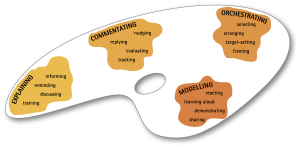

New Teachers’ Palette

The new Teachers’ Palette distills the types of actions teachers need to take in order to create the conditions necessary for learning behaviours not only to be used but to be habituated; a metacognitive approach. Why the changes?…..because over the last six or seven years many schools have found the need to become more performance focused, curriculums have become overloaded and with more difficult content, teachers have been put under greater administrative strain… and so forth. Hence the green palette takes on the uncomfortable truth that classrooms, in many schools, have become more teacher focused with students being given less responsibility for their learning. The journey to learning centred, metacognitive classrooms now appears to have more hurdles to overcome and the new palette attempts to address this.
In moving from a more traditional classroom culture to a learning friendly culture, the teacher’s role becomes one of surfacing learning; to make learning public; to train some of the tricky bits; to talk about it; to recognise and celebrate it as it happens; to nudge it along, assisting students to grow their learning capacities; and to design activity to stretch a wide range of learning habits. This uncovering of learning ensures students discover, use, understand and grow their learning habits. In short, the teacher is the ultimate model of being a meta-learner and the classroom culture nurtures students as meta-learners… big time.
Below shows the basic architecture of a learning friendly culture; one that’s successful in building better learners. The text beyond the picture explores and expands these basic ideas.
What are the four cultural shifts that, taken together, move a traditional classroom culture to a learning-friendly culture?
Ron Ritchhart observes in Creating Cultures of Thinking:
“The culture of the classroom teaches. It not only sets the tone for learning but also determines what gets learned. The messages sent through the culture of the classroom communicate to students what it means to think and learn well. These messages are a curriculum in themselves, teaching students how to learn and ways of thinking.”
Moving to establish learning-friendly metacognitive cultures entails four shifts. A shift in relationships, a shift in the language, a shift in how learning is constructed, and a shift in what is celebrated – what is seen to matter:
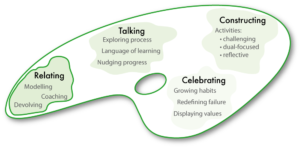 1) Relating for learning – making learning a shared responsibility: the changing roles and responsibilities of teachers and learners, where learning becomes a shared responsibility. Students are given more responsibility for their own learning, the role of the teacher changes from ‘the sage on the stage’ to ‘the guide by your side’; the role of the student moves from ‘passenger’ to ‘crew’ and ultimately ‘pilots of their own learning’;
1) Relating for learning – making learning a shared responsibility: the changing roles and responsibilities of teachers and learners, where learning becomes a shared responsibility. Students are given more responsibility for their own learning, the role of the teacher changes from ‘the sage on the stage’ to ‘the guide by your side’; the role of the student moves from ‘passenger’ to ‘crew’ and ultimately ‘pilots of their own learning’;
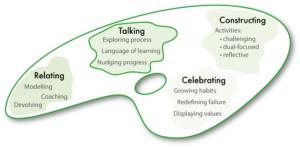
2) Talking for learning – making learning the object of conversation: the sort of language content and style to enhance learning. The way we express ourselves in the classroom creates a powerful linguistic environment that teaches young people the best of what we know about learning. The language of learning helps students to discuss, understand, and become conscious of using their learning behaviours;
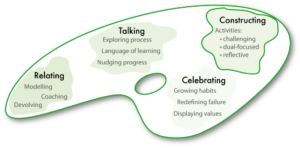
3) Constructing learning – making learning the object of learning: activities and classroom routines feed learning habits. Learning challenging activities are designed to enable students to understand both the content and the process of learning. They do this by having a dual focus – to explore content and stretch students’ use of their learning behaviours. There is a strong underpinning of not just ‘doing’ learning but reviewing and reflecting on the process in order to make meaning and apply it elsewhere;
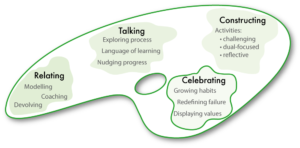
4) Celebrating learning – making learning the object of attention: the outward signs of the values that underpin the culture. In this dimension common notions of classroom learning are flipped or re-defined – being stuck is seen as interesting and mistakes valuable. Effort, questioning and taking risks are defined, recognised, attended to, acknowledged and praised. These and the recognition of the development of learning habits serve to make visible and public the underlying values of the learning friendly environment, one in which learners are being taught to be meta-learners.
Four culture shifts
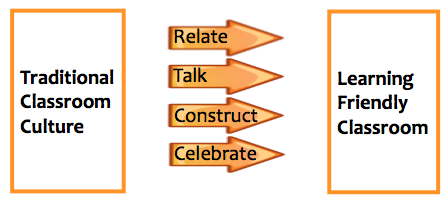
What do such changes mean for the role of learners?
For learners it’s a place where their role changes from receptivity to activity:
- they collaborate and talk about how they understand things
- they accept responsibility for learning
- they do more of the thinking
- they develop curiosity, perseverance, attentiveness, and open-mindedness
- they monitor and assess what they do
- they talk fluently about their learning behaviours
- they value mistakes, challenge, feedback
- they develop their learning behaviours consciously
- they regard themselves as improving learners
- they are able to regulate their learning
How does the role of teachers change?
For teachers it’s a place where their role changes from delivering content to constructing situations from which students learn:
- the learning process is brought to the surface, given a language, discussed, looked for, celebrated
- learning processes are modelled
- teachers act as learning coaches
- few lessons are simply talk-and chalk
- lessons contain challenges and activities that get students thinking and learning for themselves
- teachers encourage students to explore a challenging question, problem or assertion
- teachers enable students to become observers and regulators of their own learning
- teachers keep thinking ‘What’s the least I can do to get productive learning happening (again)?’
This general philosophy is not new of course. There have long been many advocates for learning where students are more active and engaged. But because learning-centred teachers have a particularly rich conception of learning and the habits that underpin it, they are able to design nudges and activities that target quite specific aspects of learning behaviours. They have become Meta-Teachers, taking a more detailed and forensic approach to learning and thus coaching their students to become meta-learners.
What do these changes in teachers’ practice amount to?
The Teachers’ Palette framework to build learning friendly cultures
Learning-friendly cultures systematically cultivate habits and attitudes that enable young people to regulate their learning and to face difficulty calmly, confidently and creatively. This means moving the focus from what teachers do to a focus on what learners do.
The teachers’ palette diagram below distils the key teacher behaviours associated with a learning friendly culture.
What questions might you ask yourself at this point?
Something to think about
- Who is working hardest in your classrooms – teachers or students? What does this tell you about the extent to which students are being enabled to take responsibility for their own learning?
- What is talked about in classrooms – content, learning, or both? Who talks about it – teachers, students or both?
- Is reflection a regular feature in lessons? Who does the reflecting – teachers for students, or students for themselves? What is reflected on – content acquisition or the learning process, or both?
- What is celebrated – high attainment or successful learning? What do students value most highly – learning from mistakes or getting it right first time?
- How much of a culture shift is needed.

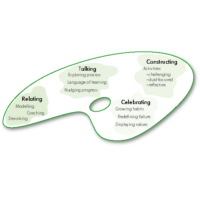
No comments yet.